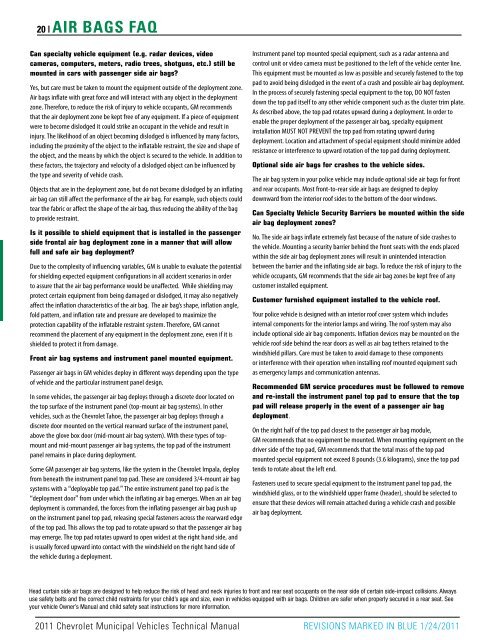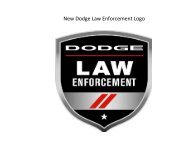chevrolet municipal vehicles technical manual - Adamson Industries
chevrolet municipal vehicles technical manual - Adamson Industries
chevrolet municipal vehicles technical manual - Adamson Industries
Create successful ePaper yourself
Turn your PDF publications into a flip-book with our unique Google optimized e-Paper software.
20 | aIr bags faq<br />
can specialty vehicle equipment (e.g. radar devices, video<br />
cameras, computers, meters, radio trees, shotguns, etc.) still be<br />
mounted in cars with passenger side air bags?<br />
Yes, but care must be taken to mount the equipment outside of the deployment zone.<br />
Air bags inflate with great force and will interact with any object in the deployment<br />
zone. Therefore, to reduce the risk of injury to vehicle occupants, GM recommends<br />
that the air deployment zone be kept free of any equipment. If a piece of equipment<br />
were to become dislodged it could strike an occupant in the vehicle and result in<br />
injury. The likelihood of an object becoming dislodged is influenced by many factors,<br />
including the proximity of the object to the inflatable restraint, the size and shape of<br />
the object, and the means by which the object is secured to the vehicle. In addition to<br />
these factors, the trajectory and velocity of a dislodged object can be influenced by<br />
the type and severity of vehicle crash.<br />
Objects that are in the deployment zone, but do not become dislodged by an inflating<br />
air bag can still affect the performance of the air bag. For example, such objects could<br />
tear the fabric or affect the shape of the air bag, thus reducing the ability of the bag<br />
to provide restraint.<br />
Is it possible to shield equipment that is installed in the passenger<br />
side frontal air bag deployment zone in a manner that will allow<br />
full and safe air bag deployment?<br />
Due to the complexity of influencing variables, GM is unable to evaluate the potential<br />
for shielding expected equipment configurations in all accident scenarios in order<br />
to assure that the air bag performance would be unaffected. While shielding may<br />
protect certain equipment from being damaged or dislodged, it may also negatively<br />
affect the inflation characteristics of the air bag. The air bag’s shape, inflation angle,<br />
fold pattern, and inflation rate and pressure are developed to maximize the<br />
protection capability of the inflatable restraint system. Therefore, GM cannot<br />
recommend the placement of any equipment in the deployment zone, even if it is<br />
shielded to protect it from damage.<br />
Front air bag systems and instrument panel mounted equipment.<br />
Passenger air bags in GM <strong>vehicles</strong> deploy in different ways depending upon the type<br />
of vehicle and the particular instrument panel design.<br />
In some <strong>vehicles</strong>, the passenger air bag deploys through a discrete door located on<br />
the top surface of the instrument panel (top-mount air bag systems). In other<br />
<strong>vehicles</strong>, such as the Chevrolet Tahoe, the passenger air bag deploys through a<br />
discrete door mounted on the vertical rearward surface of the instrument panel,<br />
above the glove box door (mid-mount air bag system). With these types of topmount<br />
and mid-mount passenger air bag systems, the top pad of the instrument<br />
panel remains in place during deployment.<br />
Some GM passenger air bag systems, like the system in the Chevrolet Impala, deploy<br />
from beneath the instrument panel top pad. These are considered 3/4-mount air bag<br />
systems with a “deployable top pad.” The entire instrument panel top pad is the<br />
“deployment door” from under which the inflating air bag emerges. When an air bag<br />
deployment is commanded, the forces from the inflating passenger air bag push up<br />
on the instrument panel top pad, releasing special fasteners across the rearward edge<br />
of the top pad. This allows the top pad to rotate upward so that the passenger air bag<br />
may emerge. The top pad rotates upward to open widest at the right hand side, and<br />
is usually forced upward into contact with the windshield on the right hand side of<br />
the vehicle during a deployment.<br />
Instrument panel top mounted special equipment, such as a radar antenna and<br />
control unit or video camera must be positioned to the left of the vehicle center line.<br />
This equipment must be mounted as low as possible and securely fastened to the top<br />
pad to avoid being dislodged in the event of a crash and possible air bag deployment.<br />
In the process of securely fastening special equipment to the top, DO NOT fasten<br />
down the top pad itself to any other vehicle component such as the cluster trim plate.<br />
As described above, the top pad rotates upward during a deployment. In order to<br />
enable the proper deployment of the passenger air bag, specialty equipment<br />
installation MUST NOT PREVENT the top pad from rotating upward during<br />
deployment. Location and attachment of special equipment should minimize added<br />
resistance or interference to upward rotation of the top pad during deployment.<br />
Optional side air bags for crashes to the vehicle sides.<br />
The air bag system in your police vehicle may include optional side air bags for front<br />
and rear occupants. Most front-to-rear side air bags are designed to deploy<br />
downward from the interior roof sides to the bottom of the door windows.<br />
can Specialty Vehicle Security Barriers be mounted within the side<br />
air bag deployment zones?<br />
No. The side air bags inflate extremely fast because of the nature of side crashes to<br />
the vehicle. Mounting a security barrier behind the front seats with the ends placed<br />
within the side air bag deployment zones will result in unintended interaction<br />
between the barrier and the inflating side air bags. To reduce the risk of injury to the<br />
vehicle occupants, GM recommends that the side air bag zones be kept free of any<br />
customer installed equipment.<br />
customer furnished equipment installed to the vehicle roof.<br />
Your police vehicle is designed with an interior roof cover system which includes<br />
internal components for the interior lamps and wiring. The roof system may also<br />
include optional side air bag components. Inflation devices may be mounted on the<br />
vehicle roof side behind the rear doors as well as air bag tethers retained to the<br />
windshield pillars. Care must be taken to avoid damage to these components<br />
or interference with their operation when installing roof mounted equipment such<br />
as emergency lamps and communication antennas.<br />
Recommended GM service procedures must be followed to remove<br />
and re-install the instrument panel top pad to ensure that the top<br />
pad will release properly in the event of a passenger air bag<br />
deployment.<br />
On the right half of the top pad closest to the passenger air bag module,<br />
GM recommends that no equipment be mounted. When mounting equipment on the<br />
driver side of the top pad, GM recommends that the total mass of the top pad<br />
mounted special equipment not exceed 8 pounds (3.6 kilograms), since the top pad<br />
tends to rotate about the left end.<br />
Fasteners used to secure special equipment to the instrument panel top pad, the<br />
windshield glass, or to the windshield upper frame (header), should be selected to<br />
ensure that these devices will remain attached during a vehicle crash and possible<br />
air bag deployment.<br />
Head curtain side air bags are designed to help reduce the risk of head and neck injuries to front and rear seat occupants on the near side of certain side-impact collisions. Always<br />
use safety belts and the correct child restraints for your child’s age and size, even in <strong>vehicles</strong> equipped with air bags. Children are safer when properly secured in a rear seat. See<br />
your vehicle Owner’s Manual and child safety seat instructions for more information.<br />
2011 Chevrolet Municipal Vehicles Technical Manual REVISIONS MARKED IN BLUE 1/24/2011



